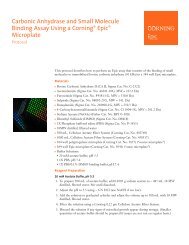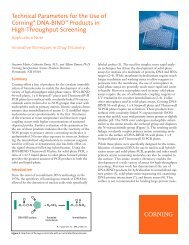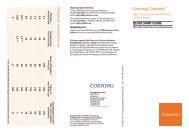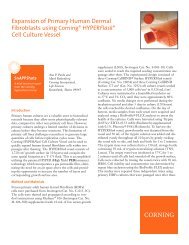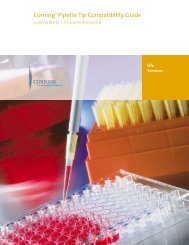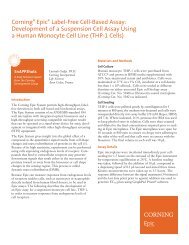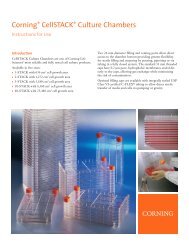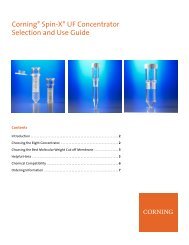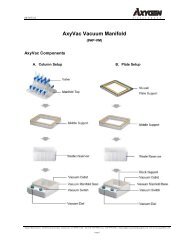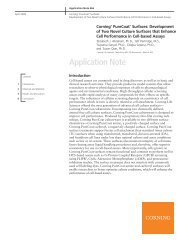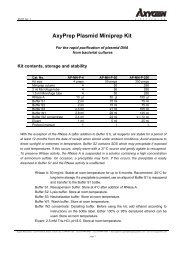ELISA Technical Bulletin - No. 4 - Corning Incorporated
ELISA Technical Bulletin - No. 4 - Corning Incorporated
ELISA Technical Bulletin - No. 4 - Corning Incorporated
You also want an ePaper? Increase the reach of your titles
YUMPU automatically turns print PDFs into web optimized ePapers that Google loves.
Optimizing the Separation Step on<br />
96 Well Plates<br />
<strong>ELISA</strong> <strong>Technical</strong> <strong>Bulletin</strong> - <strong>No</strong>. 4<br />
Judy Gibbs<br />
<strong>Corning</strong> <strong>Incorporated</strong><br />
Life Sciences<br />
Kennebunk, ME<br />
Table of Contents<br />
Introduction . . . . . . . . . . . . . . . . . . . . . . . . . . . . 1<br />
Wash Solution Composition . . . . . . . . . . . . . . . 2<br />
Effect of Fluid Force on Immobilized<br />
Biomolecules . . . . . . . . . . . . . . . . . . . . . . . . . . . 2<br />
Optimizing the Aspiration Step . . . . . . . . . . . . . 2<br />
Conclusion . . . . . . . . . . . . . . . . . . . . . . . . . . . . 4<br />
References. . . . . . . . . . . . . . . . . . . . . . . . . . . . . 5<br />
Introduction<br />
Enzyme Linked Immunosorbent Assays (<strong>ELISA</strong>),<br />
regardless of whether the antigen or antibody is<br />
bound to the surface, require a physical separation<br />
step to remove free from bound analyte. This is<br />
typically referred to as a “wash step”. For multiple<br />
well plates, washing is accomplished by consecutive<br />
filling of the wells with wash solution followed<br />
by emptying them via decanting or aspirating. In<br />
order to maximize assay precision and sensitivity,<br />
complete separation of free from bound fractions<br />
is required. We have found that the wash step can<br />
be a major factor affecting assay precision and<br />
optimizing this step is crucial to obtaining consistent<br />
and reliable results. Some of the factors<br />
associated with the wash step that should be<br />
optimized are:<br />
◗ the composition of the wash solution,<br />
Life<br />
Sciences<br />
◗ the dispensing mechanism used to fill the<br />
wells with wash solution, and<br />
◗ the fluid aspiration conditions, including<br />
vacuum strength.<br />
The use of a well-maintained automated microplate<br />
washer is a positive step in assuring precise,<br />
accurate washing for every assay.
2<br />
Wash Solution Composition<br />
The wash solution should be comprised<br />
of a physiological (enzyme friendly)<br />
buffer, such as phosphate buffered saline,<br />
Tris buffered saline or imidazole buffered<br />
saline. We have experienced favorable<br />
results using imidazole buffered saline,<br />
which is compatible with all the enzymes<br />
typically used for enzyme immunoassays.<br />
When alkaline phosphatase is used, phosphate<br />
buffers should be avoided due to<br />
the effect of phosphates on the enzyme’s<br />
activity. Inorganic phosphate can act as a<br />
pseudosubstrate for alkaline phosphatase<br />
and effectively reduce its specific activity<br />
with the substrate. If peroxidase is used,<br />
sodium azide must not be added to the<br />
wash solution. Sodium azide is an inhibitor<br />
of peroxidase activity. Water is a<br />
poor wash buffer due to its variable pH<br />
and lack of protein buffering capability<br />
(surface bound proteins need to be<br />
protected from denaturation).<br />
The addition of a detergent such as<br />
Tween 20 is beneficial. Detergents aid in<br />
the removal of loosely bound protein and<br />
act as a hydrophobic blocking reagent<br />
to block sites on the surface that may<br />
become available due to protein desorption<br />
during the wash step. A concentration<br />
of 0.01 to 0.03% is recommended.<br />
The goal is to remove loosely bound<br />
protein without stripping off specifically<br />
bound protein or inactivating enzymes,<br />
which could occur if detergent concentrations<br />
are too high, when greater<br />
than their critical micelle concentration<br />
(CMC) value.<br />
Effect of Fluid Force on<br />
Immobilized Biomolecules<br />
To achieve precise washing, an equal volume<br />
of wash solution should be dispensed<br />
into each well of a microplate with equal<br />
force. The gentle addition of wash solution<br />
that occurs with an automated washer<br />
is ideal. A gentle flow of fluid into<br />
the well removes free protein without<br />
stripping off bound protein. When the<br />
addition of wash solution is too vigorous,<br />
protein can be stripped off and enzyme<br />
activity inactivated by the sheer force of<br />
the fluid as it enters the well. An example<br />
of vigorous and inconsistent wash solution<br />
addition is the use of a squirt bottle to<br />
dispense the wash solution. The force<br />
of fluid from well to well cannot be controlled<br />
and is usually too vigorous to<br />
allow precise washing.<br />
The volume of the wash solution dispensed<br />
per well should be high enough to cover<br />
the entire surface area coated with antigen<br />
or antibody. We recommend that the<br />
entire well be filled (approximately 300 µL<br />
per well for a 96 well plate).<br />
It is often tempting to increase the vigorousness<br />
of the wash buffer dispensing<br />
step whenever background is higher than<br />
desired in an effort to remove unbound<br />
protein that could be causing the higher<br />
than expected values. However, this is<br />
not recommended for the above stated<br />
reasons. Instead of increasing the fluid<br />
force into the wells, increasing the number<br />
of wash cycles will help eliminate<br />
background problems caused by residual<br />
unbound protein left in the wells.<br />
The optimal number of wash cycles can<br />
be determined through experimentation;<br />
however, our results indicate that less<br />
than three wash cycles leaves residual<br />
unbound protein in the wells and more<br />
than five results in unwanted protein<br />
desorption. Since washing is actually a<br />
dilution process (some of the original<br />
solution remains after each aspiration step<br />
as a film of fluid on the surface ), the goal<br />
is to dilute the original solution as much<br />
as possible without stripping off bound<br />
protein. (<strong>No</strong>te: total aspiration is undesirable<br />
due to the denaturation effect of drying<br />
out the surface bound protein.) This<br />
optimal dilution scheme occurs between<br />
3 and 5 cycles. The addition of a five<br />
minute soak step following the last wash<br />
cycle is extremely beneficial in terms<br />
of removing the remaining unbound<br />
protein that may be trapped in the<br />
well corners.<br />
Optimizing the Aspiration Step<br />
The major cause of precision problems<br />
that are associated with the wash step<br />
occurs during aspiration. Although the<br />
best method of removing liquid from<br />
the wells (in relation to Coefficient of
3<br />
Variation; CV) is hand decanting, aspiration<br />
can be used, if optimized, to reduce<br />
the adverse effects to the surface bound<br />
protein. The items requiring optimization<br />
are (i) needle position, (ii) aspiration<br />
direction (top-down), and (iii) vacuum<br />
strength.<br />
For flat bottom wells, the aspiration<br />
needles should be positioned midway<br />
between the center and edge of the well.<br />
(The center position should be occupied<br />
by the dispense needles.) The needles<br />
should be distanced from the bottom of<br />
the wells such that they do not touch the<br />
surface. Ideally, the surface should never<br />
be completely dried out during the wash<br />
step, so the position of the needles should<br />
allow a small amount of liquid to be left<br />
in the wells after aspiration is complete.<br />
This small liquid volume accumulates at<br />
the edge of the well because of the gravitational<br />
forces on the film of liquid left on<br />
the sidewalls. After the final wash cycle,<br />
this small volume can be hand decanted<br />
by rapping the plate upside down on an<br />
absorbent paper towel. It is important<br />
to remove this residual liquid prior to<br />
adding substrate, since wash solutions<br />
containing detergents can suppress product<br />
(colorimetric, fluorometric, or lumi-<br />
Table 1. Edge Effect from a 20 Minute Time Delay<br />
MIN 0.224<br />
MAX 0.759<br />
RANGE 0.535<br />
AVG 0.669<br />
STD 0.103<br />
CV 15.365<br />
LOW W 66.5%<br />
HIGH W 13.5%<br />
Wells >10%<br />
of the Average<br />
Wells
4<br />
Table 2. Effect of Aspiration Vacuum Strength on Assay Precision<br />
Vacuum <strong>No</strong>. of <strong>No</strong>. of Plates High Low<br />
(mmHg) Plates Run Out-of-Spec CV Well Well<br />
400 112 0 2.0 4.8 5.2<br />
550 10 2 3.3 7.3 8.4<br />
250 10 3 2.4 7.2 7.1<br />
activity. Table 1 depicts the effect of drying<br />
on enzymatic activity after a 20 minute<br />
delay from aspiration after the last wash<br />
cycle to the addition of substrate. The<br />
expected optical density (OD) reading for<br />
this assay when performed correctly is<br />
1.200. As the data show, the color development<br />
is severely suppressed after 20<br />
minutes without fluid in the wells. Edge<br />
wells are affected more than inner wells<br />
as shown by their lower OD’s. (Wells<br />
represented by a “0” are within 10% of<br />
the average OD for the entire plate. Only<br />
wells that lie outside this 10% range show<br />
up as high or low wells).<br />
Optimization of vacuum strength is crucial<br />
to maintaining low CV’s in an assay.<br />
If vacuum strength (measured in mm Hg<br />
or PSI) is too high, shear forces and air<br />
currents will denature bound protein and<br />
inactivate enzymes. If vacuum strength is<br />
too low, excessive residual wash solution<br />
will remain in the wells and suppress<br />
enzymatic activity. Each type of well<br />
shape (flat or round) and type of plate<br />
(solid plate, strip plate, different manufacturers’<br />
plates) have their own optimal<br />
vacuum strength. However, we have<br />
found that 400mm Hg is optimal for<br />
most products (see Table 2 for results).<br />
Conclusion<br />
Crucial to assay precision is optimization<br />
of the separation step. Virtually all<br />
unbound proteins must be removed for<br />
maximum sensitivity, specificity, and precision<br />
to be realized. What would appear<br />
to be a simple and foolproof manipulation<br />
for multiple well plates — washing — is<br />
actually a step in an immunoassay that<br />
can cause the most troublesome precision<br />
problems. A balance needs to be struck<br />
between leaving too much unbound<br />
protein behind and stripping off or denaturing<br />
specifically bound protein. This<br />
balance can be achieved by adhering to<br />
the following recommendations:<br />
◗ The wash solution should be a physiological<br />
buffer that will not interfere<br />
with immunological or enzymatic<br />
activity and should contain a low<br />
concentration of detergent to aid in<br />
the removal of unbound protein.<br />
◗ An equal volume of wash solution<br />
should be dispensed into each well<br />
with equal (gentle) force to avoid<br />
stripping off bound protein.<br />
◗ Wells should be washed a minimum<br />
of three times and a maximum of five<br />
times for best results. The addition of<br />
a 5 minute soak period following the<br />
final wash cycle will aid in the removal<br />
of unbound protein trapped in the<br />
well corners.<br />
◗ Aspiration should be controlled so<br />
that the well surface does not dry out.<br />
Optimizing the vacuum strength is<br />
crucial to good assay precision.<br />
◗ Finally, the well surface should be<br />
kept moist at all times. When running<br />
multiple plates, keep the wells filled<br />
with wash solution until ready to proceed<br />
with the next step or leave the<br />
plates inverted on a wet paper towel to<br />
keep the surface hydrated during delays.<br />
These are the essential ingredients in<br />
optimizing the separation step of an<br />
<strong>ELISA</strong>.
5<br />
<strong>Technical</strong> Assistance<br />
For additional <strong>ELISA</strong> technical support<br />
and bulletins or product information,<br />
please visit the <strong>Corning</strong> Life Sciences<br />
website at www.<strong>Corning</strong>.com/lifesciences<br />
or call 1-800-492-1110.<br />
References<br />
1. Bjerrum, O.J. and Heegaard, N.H.H.<br />
Handbook of Immunoblotting of Proteins,<br />
Volume 1. Boca Raton, Florida: CRC<br />
Press, Inc.: 1988.<br />
2. Craig, J.C., et. al. Journal of Biological<br />
Standardization. 17; 1989; 125-135.<br />
3. Engvall, E. & Perlmann, P.<br />
Immunochemistry. 8:871; 1971.<br />
Revised 7/01<br />
<strong>Corning</strong> <strong>Incorporated</strong><br />
Life Sciences<br />
45 Nagog Park<br />
Acton, MA 01720<br />
t 1.800.492.1110<br />
f 1.978.635.2476<br />
www.corning.com/lifesciences<br />
4. Gardas, A. & Lewartowska, A. Journal of<br />
Immunological Methods. 106; 1988; 251-<br />
255.<br />
5. Graves, H.C.B. Journal of Immunological<br />
Methods. 111; 1988; 157-166.<br />
6. Kenny, G.E. and Dunsmoor, C.L. Israel.<br />
Journal of Medical Sciences. 23; 1987;<br />
732-734.<br />
7. Maggio, E.T. Enzyme Immunoassay. Boca<br />
Raton, Florida: CRC Press, Inc.; 1980.<br />
8. Stenberg, M. & Nygren, H. Journal of<br />
Immunological Methods. 113; 1988; 3-15.<br />
9. Vogt, R.F., et. al. Journal of Immunological<br />
Methods. 101; 1987; 43-50.<br />
<strong>Corning</strong> is a registered trademark of <strong>Corning</strong> <strong>Incorporated</strong>, <strong>Corning</strong>, New York.<br />
<strong>Corning</strong> <strong>Incorporated</strong>, One Riverfront Plaza, <strong>Corning</strong>, NY 14831-0001



